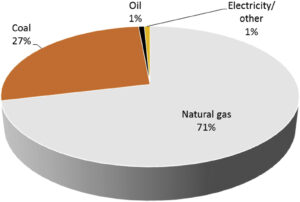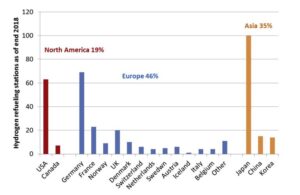Matthieu Schlapbach
Global carbon emissions stem from many different sources. On of them is road transport. In this blogpost, I look at the prospects of hydrogen and fuel cell vehicles as a solution for decarbonizing the transport sector.
Our way of burning fossil fuels to advance through life, either on the road or in general, is not sustainable. One of them is the transport sector which takes up 16.2% of all emissions, out of which 11.9% stemmed from road transport (Ritchie et al., 2020). In Switzerland, the transport sector causes 32% of emissions, excluding air transport (Federal Office of the Environment, 2020). So, we are looking in more sustainable directions like hydrogen and fuel cell cars, as they have zero greenhouse gas emissions. Since the last few years, much attention is given to electric vehicles, which –will contribute strongly to the much-needed decarbonization of our transport vehicles. Electric vehicles are limited due to their overall battery technology not being able to store really large amounts of energy without becoming either very complex or exceedingly big. Hydrogen does bring high energy density to the table, and I will try to highlight different aspects and barriers of implementation into our everyday life, based on Ajanovic & Haas, 2021.
What do we have as of today?
Hydrogen and fuel cell vehicles are considered a technology of the future. How much into the future have we advanced now?
Hydrogen, as a secondary energy carrier, can be produced by using energy from any primary energy source, e.g. fossil, nuclear or renewable. Today, 71% of hydrogen is produced by using the method called steam methane reforming. Methane is heated with steam and, with a catalyst, produces a mix of carbon monoxide and hydrogen. Using this method, about 10 kg of CO2 are produced for every kilogram of hydrogen (Ajanovic & Haas, 2021). It is of interest to use renewable energy sources to produce hydrogen, which would mean that the hydrogen should be produced via electrolysis , which is the most feasible way. Photocatalysis and photoelectrochemistry are potent way to produce hydrogen aswell, but still in development. So far, electrolysis only contributes to 0.1% of all the hydrogen produced. This process not only uses electricity, but it also requires water. For every kilogram of hydrogen, about 9 litres of H2O are used. This could pose a problem in areas under water stress. There are upcoming ideas to use seawater or other non-pure water sources to produce hydrogen and other useful substances, which could solve the problem of water scarcity in respect to hydrogen electrolysis (Khan et al., 2021).
For the success of hydrogen and fuel cell vehicles in our society, there has to be a switch in the energy sources used to produce the energy dense fuel. It is also worth mentioning that one third of the global hydrogen supply is covered with hydrogen produced as a by-product in facilities designed to produce something else (Ajanovic & Haas, 2021). Hydrogen as an energy carrier is very versatile and can enable the diversification of energy sources in the transport sector. Current use of hydrogen in the transport sector is very low with 0.01 million tonnes per year, as there were only about 13’000 fuel cell vehicles operating worldwide in the year 2019. The USA, Japan, China and Europe are the main users of these fuel cell vehicles.
Why are there so few hydrogen vehicles?
The technology is ready, but currently, fuel cell vehicles are just not economically competitive with either combustion engine or battery-powered vehicles because the production costs are still higher compared to the two other mentioned engines. It is important to note that hydrogen vehicles still drive on electric engines, but the fuel cells replace the batteries for electric flow. Fuel cell vehicles could be used instead of electric vehicles in cases where there is a need for longer driving range and higher load capacity.
Another reason for so few fuel cell vehicles is most probably the low density of infrastructure. The deployment of hydrogen refuelling stations is making some progress, so it will only be a question of time until the infrastructure is sufficiently expanded to house a big demand of hydrogen refuelling stations.
How hydrogen fuel cell vehicles could make a bigger appearance in the market
One of the issues that electric vehicles bring up is the unsolved problem of battery recycling. There is also an imbalance between electricity supply and demand following the use of variable renewable energy sources. As long as the problem of energy storage for e.g. solar energy is not solved, there is a need for additional energies, which do not rely solely on electric energy. Electric vehicles do not provide a definitive solution in the large vehicle segments due to their limited capability (Ajanovic & Haas, 2021). In addition to vehicles for the transport sector, hydrogen could also be used as an option for energy storage in the field of renewable energy sources, much like pumped hydro storage for example. Now the question is, what does it really need to implement hydrogen vehicles into our way of driving? There are three factors contributing to the implementation of these vehicles (Ajanovic & Haas, 2021).
First of all, the vehicles have to be affordable. The investment costs are still too high, but they should drop due to the process of technological learning. This should further decrease the price difference between internal combustion engine cars and hydrogen fuel cell cars. In addition, the rising gas prices will also contribute to levelling this price difference. As of today, there are already different models of fuel cell vehicles available for consumers to buy. They mostly are produced by japanese manufacturers. These fuel cell vehicles are very comparable to the internal combustion engine cars. The driving range is between 400 and 550 km per tank and the time it takes to refuel the vehicle is about 3 – 5 minutes. Fuel cell vehicles are quiet and have zero emissions at the point of use.
Secondly, the adoption of hydrogen cars relies on the expansion of infrastructure. The numbers are rising every year, with 540 hydrogen refuelling stations worldwide at the end of 2020 and 685 stations globally a year later. With 363 stations in Asia, mainly Japan, Korea and China, Europe has a smaller portion with 228 stations throughout Germany, France, the UK, Switzerland and the Netherlands. Switzerland posesses 12 stations as of now. Seeing the trend, this second factor should not pose much of a problem in respect of the adoption of hydrogen vehicles.
Thirdly, the future role of hydrogen fuel cell vehicles is heavily dependant on policies. The support for such policies is and will continue to be driven by national priorities such as air quality, climate change, etc. The adoption of fuel cell cars is also indirectly supported by all the upcoming bans on internal combustion engine car production, higher standards for CO2 emissions from new cars and so on. But the major problem for deployment of hydrogen and fuel cell vehicles is the lack of technology standards, which would reduce the risk of investment and further drive economies of scale. In addition, the public acceptance of this new technology has to be increased by further research and development projects.
Lastly, another point driving the amount of public acceptance is safety. Hydrogen is very flammable, and care must be taken when using hydrogen. It has a low ignition energy which makes it very challenging to be handled in safe ways in case of accidents (Foorginezhad et al., 2021). The risk of explosion is present too. The safe operation of fuel cell and hydrogen vehicles must be demonstrated as well if the acceptance is to be increased.
The cost of adopting fuel cell vehicles is still high and so the market uptake directly correlates to GDP per capita. The highest investments in this technology are concentrated to the few countries seen in Figure 2.
Conclusion
Many factors influence the implementation of new technologies such as hydrogen and fuel cell vehicles. I think that it is important to support the development of safety and usability in this field as I see it as a very potent contributor to decarbonization of the transport sector. The researchers should then be able to provide sufficient alternatives to the conventional production of hydrogen, which misses the goal of no CO2 emissions. I am confident that the future will bring better electrolysis systems and and even better dynamic of useful by-products in industry. If the cost of the vehicles further drops, the production of hydrogen is adapted to use renewable energy sources and the infrastructure continues to be improved I see a bright future in them. There need to be enough policies supporting the technologies and these alternative transport systems in general, decarbonization is not achieved in one day.
References
Ajanovic, A., & Haas, R. (2021). Prospects and impediments for hydrogen and fuel cell vehicles in the transport sector. International Journal of Hydrogen Energy, 46(16), 10049–10058. https://doi.org/10.1016/j.ijhydene.2020.03.122
Federal Office for the Environment. Switzerland’s climate policy.
Ritchie, H., Roser, M., & Rosado, P. (2020). CO₂ and Greenhouse Gas Emissions. https://ourworldindata.org/co2-and-other-greenhouse-gas-emissions
Khan, M. A., Al-Attas, T., Roy, S., Rahman, M. M., Ghaffour, N., Thangadurai, V., Larter, S., Hu, J., Ajayan, P. M., & Kibria, M. G. (2021). Seawater electrolysis for hydrogen production: A solution looking for a problem? Energy and Environmental Science, 14(9), 4831–4839. https://doi.org/10.1039/d1ee00870f
Foorginezhad, S., Mohseni-Dargah, M., Falahati, Z., Abbassi, R., Razmjou, A., & Asadnia, M. (2021). Sensing advancement towards safety assessment of hydrogen fuel cell vehicles. In Journal of Power Sources (Vol. 489). Elsevier B.V. https://doi.org/10.1016/j.jpowsour.2021.229450

